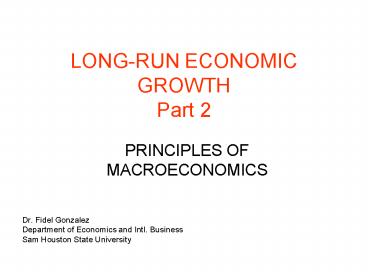LONGRUN ECONOMIC GROWTH Part 2 - PowerPoint PPT Presentation
1 / 4
Title:
LONGRUN ECONOMIC GROWTH Part 2
Description:
LONG-RUN ECONOMIC GROWTH. Part 2. Dr. Fidel Gonzalez. Department of ... In the first part of 'Lon-run Economic Growth' s, we observed that most low ... – PowerPoint PPT presentation
Number of Views:47
Avg rating:3.0/5.0
Title: LONGRUN ECONOMIC GROWTH Part 2
1
LONG-RUN ECONOMIC GROWTHPart 2
PRINCIPLES OF MACROECONOMICS
- Dr. Fidel Gonzalez
- Department of Economics and Intl. Business
- Sam Houston State University
2
- In the first part of Lon-run Economic Growth
slides, we observed that most low-income
countries have small rates of growth. However,
our model would predict the opposite countries
with low K/L have small diminishing returns to
capital, so increases in K/L will bring bigger
changes in Y/L compared to developed countries. - This begs the following question
- Q Why developing countries have not experienced
rapid growth? - There are several explanations and if you ask
anybody they can probably tell you why some
countries have not developed as they should.
However, we can summarize the main reasons in the
following - Failure to enforce the law.
- Wars and revolutions.
- Poor public education and health
- Low rates of savings and investment
3
- Failure to enforce the law
- In many developing countries it is difficult to
enforce the law and this affect their economic
production. When the law is difficult to enforce
we observe the following problem - Some people do not pay taxes and those resource
could be used to improve a countrys provision of
public goods such as education, research and
development, highways, ports, airports, among
others. - Property rights are not properly protected so
inventors and businesses are not willing to
produce new technologies because they do not
capture the full benefit of their inventions. - Investments and private property are poorly
protected so people have no incentive to buy
private property.
4
2) Wars and revolution Wars and revolution
destroy an economys ability to produce. It
reduces the infrastructure and labor. That is,
capital and labor decrease during wars. 3) Poor
public education and health Having good
education increases a countrys ability to
generate and adapt new technologies. Higher
public health also generates healthier workers
which also producer more productive workers.
Moreover, better health also increases the amount
of workers in a country. 4) Low rates of savings
and investment Developing countries have low
savings and investment. That translates into
lower capital level and therefore lower
productivity.































